
Modelling Primordial Stars in MESA Stellar Evolution Code
In my final year at Portsmouth, I decided to participate in a research opportunity with Dr Daniel J. Whalen. Dr Whalen has been involved in the detection of Supermassive Primordial Stars and has been published in recognised Astrophysical Journals many times. The inspiration for this research project were from his work on two academic papers:
-
On the detection of supermassive primordial stars. II. Blue supergiants (Paper 1)
-
ON THE DETECTION OF SUPERMASSIVE PRIMORDIAL STARS (Paper 2)
It involved using a stellar evolution code (MESA) to simulate the formation of supermassive primordial stars in vast, hot, rapidly accreting gas clouds. Then, an analysis of those findings to primarily determine the temperature, star classifcation, and the lifetime of such stars. After which a presentation of our findings was compulsary, along with a final report.
The authors are as follows:
Thomas McRobie, Daniel Whalen, Nicholas Herrington, David Jones, Graziella Arena
The Project
Modelling Primordial Supermassive Stars in MESA
Quasars are massive, ancient, and extremely violent astronomical objects. They formed billions of years ago and each consumes hundreds of solar masses worth of material every year.
Current models show they evolved from the mergers of primordial stars and black holes, a process taking billions of years. However, observations have found them at unusually redshifts, meaning they formed too soon after The Big Bang for this model to hold true.
So, how are they there? My project is to find out just that. Theory outlined in Chandrasekhar et al. (1964) shows a new form of stellar collapse, where incredibly large stars which we call Supermassive Primordial Stars undergo. Due to the masses and temperatures these stars reach, they also have short lifespans.
When these stars undergo this form of stellar collapse, they would form what is called a Direct Collapse Black Hole. This would result in a more efficient collapse, creating a larger Black Hole.
These larger black holes could, in theory, be the progenitors of the oldest quasars in the Universe.
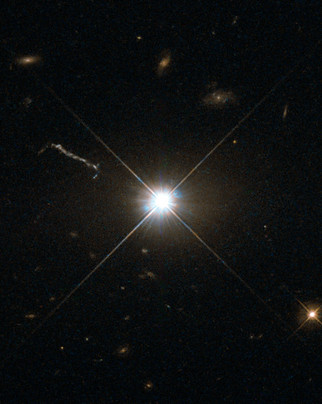
Quasar 3C_273, one of the brightest quasars in the sky. Source: https://en.wikipedia.org/wiki/3C_273
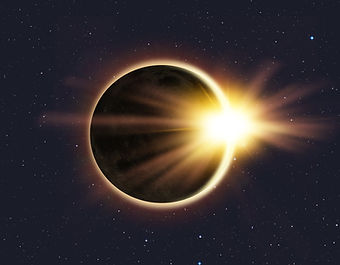
MESA
Modules for Experiments in Stellar Astrophysics
This is a stellar evolution code (written by Rich Townsend) that is in the public domain, allowing astrophysicists around the world to simluate the birth, life-cycle, and death of Stars.
This code was used specifically because of its capability of simulating stars with zero metallicity and rapid mass gain i.e. Primordial Supermassive Stars.

Results
Present day massive Stars evolve dramatically, as the figures below demonstrate. With lifetimes of only a few million years, standard methods of energy generation (such as proton-proton chain reactions) are quickly replaced by CNO cycles and triple-alpha reactions. This causes a faster transition between Hydrogen burning and Helium burning, as shows by a "Helium flash". This marks the beginning of the end for these stars, as they then burn heavier elements, expand into Red Giants, and die.

Helium Flash
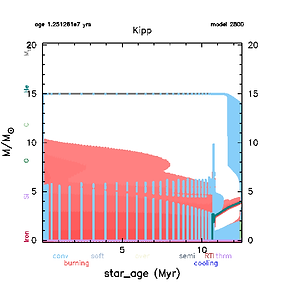
Left: A Hertzsprung-Russel (H-R) Diagram of a 15 solar mass star, with the pre-main sequence beginning at the red dot, and the post-main sequence ending at the green dot. Right: A Kippenhahn Diagram showing the radiative zones (red) and the convective zones (blue).
A Primordial Supermassive Star undergoes an even more turbulent life, in an even shorter time. With a lifetime of approximately 100,000 years and the radiative zone of the star occupying a much higher proportion of the stars enclosed mass, the Helium flash occurs significant sooner as shown by the figures below.
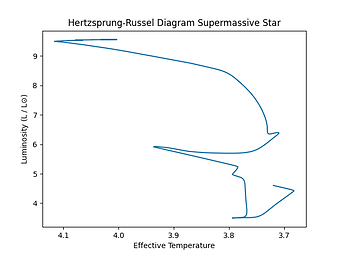
Helium Flash
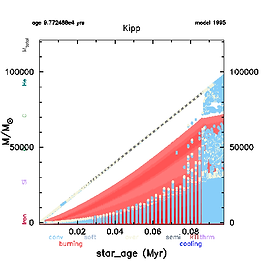
Left: A Hertzsprung-Russel Diagram of a Supermassive Star, with the pre-main sequence beginning at the red dot, and the post-main sequence ending at the green dot. Right: A Kippenhahn Diagram showing the radiative zones (red) and the convective zones (blue).
Most notably, the H-R diagram does not end in the top right like the earlier test case. This shows the different form of stellar collapse discussed earlier, as the code terminates just prior to star death.